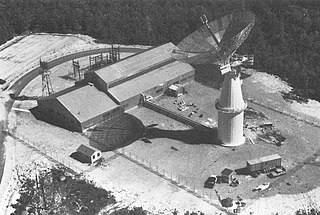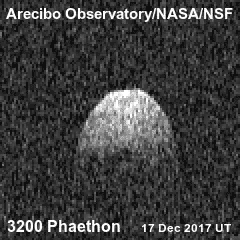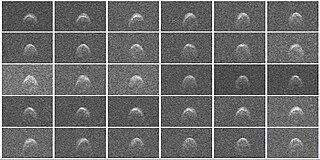Related Research Articles

4179 Toutatis is an elongated, stony asteroid and slow rotator, classified as a near-Earth object and potentially hazardous asteroid of the Apollo asteroid and Alinda asteroid groups, approximately 2.5 kilometers in diameter. Discovered by French astronomer Christian Pollas at Caussols in 1989, the asteroid was named after Toutatis from Celtic mythology.

Radar astronomy is a technique of observing nearby astronomical objects by reflecting radio waves or microwaves off target objects and analyzing their reflections. Radar astronomy differs from radio astronomy in that the latter is a passive observation and the former an active one. Radar systems have been conducted for six decades applied to a wide range of Solar System studies. The radar transmission may either be pulsed or continuous. The strength of the radar return signal is proportional to the inverse fourth-power of the distance. Upgraded facilities, increased transceiver power, and improved apparatus have increased observational opportunities.

Deep Impact was a NASA space probe launched from Cape Canaveral Air Force Station on January 12, 2005. It was designed to study the interior composition of the comet Tempel 1 (9P/Tempel), by releasing an impactor into the comet. At 05:52 UTC on July 4, 2005, the Impactor successfully collided with the comet's nucleus. The impact excavated debris from the interior of the nucleus, forming an impact crater. Photographs taken by the spacecraft showed the comet to be more dusty and less icy than had been expected. The impact generated an unexpectedly large and bright dust cloud, obscuring the view of the impact crater.

4660 Nereus, provisional designation 1982 DB, is a small asteroid. It was discovered by Eleanor F. Helin on 28 February 1982, approximately a month after it passed 4.1 million km (11 LD) from Earth.

3200 Phaethon, provisionally designated 1983 TB, is an active Apollo asteroid with an orbit that brings it closer to the Sun than any other named asteroid. For this reason, it was named after the Greek myth of Phaëthon, son of the sun god Helios. It is 5.8 km (3.6 mi) in diameter and is the parent body of the Geminids meteor shower of mid-December. With an observation arc of 35+ years, it has a very well determined orbit. The 2017 Earth approach distance of about 10 million km was known with an accuracy of ±700 m.
99942 Apophis is a near-Earth asteroid and a potentially hazardous object with a diameter of 370 metres that caused a brief period of concern in December 2004 when initial observations indicated a probability up to 2.7% that it would hit Earth on April 13, 2029. Additional observations provided improved predictions that eliminated the possibility of an impact on Earth in 2029. Until 2006, a small possibility nevertheless remained that, during its 2029 close encounter with Earth, Apophis would pass through a gravitational keyhole of no more than about 800 kilometres (500 mi) in diameter, which would have set up a future impact exactly seven years later on April 13, 2036. This possibility kept it at Level 1 on the Torino impact hazard scale until August 2006, when the probability that Apophis would pass through the keyhole was determined to be very small and Apophis' rating on the Torino scale was lowered to zero. By 2008, the keyhole had been determined to be less than 1 km wide. During the short time when it had been of greatest concern, Apophis set the record for highest rating ever on the Torino scale, reaching level 4 on December 27, 2004.
(10302) 1989 ML is an as yet unnamed near-Earth asteroid. It is approximately 0.6 km in diameter. An Amor asteroid, it orbits between Earth and Mars. It is an X-type asteroid, so its surface composition is yet unknown. It was discovered by Eleanor F. Helin and Jeff T. Alu at Palomar Observatory on 29 June 1989.

EPOXI was a compilation of NASA Discovery program missions led by the University of Maryland and principal investigator Michael A'Hearn, with co-operation from the Jet Propulsion Laboratory and Ball Aerospace. EPOXI uses the Deep Impact spacecraft in a campaign consisting of two missions: the Deep Impact Extended Investigation (DIXI) and Extrasolar Planet Observation and Characterization (EPOCh). DIXI aimed to send the Deep Impact spacecraft on a flyby of another comet, after its primary mission was completed in July 2005, while EPOCh saw the spacecraft's photographic instruments as a space observatory, studying extrasolar planets.

Comet Hartley 2, designated as 103P/Hartley by the Minor Planet Center, is a small periodic comet with an orbital period of 6.48 years. It was discovered by Malcolm Hartley in 1986 at the Schmidt Telescope Unit, Siding Spring Observatory, Australia. Its diameter is estimated to be 1.2 to 1.6 kilometres.

65803 Didymos is a sub-kilometer asteroid and binary system that is classified as a potentially hazardous asteroid and near-Earth object of the Apollo group. The asteroid was discovered in 1996 by the Spacewatch survey at Kitt Peak, and its small 160-meter minor-planet moon, named Dimorphos, was discovered in 2003. Due to its binary nature, the asteroid was then named Didymos, the Greek word for 'twin'.

3122 Florence is a stony trinary asteroid of the Amor group. It is classified as a near-Earth object and potentially hazardous asteroid. It measures approximately 5 kilometers in diameter. It orbits the Sun at a distance of 1.0–2.5 AU once every 2 years and 4 months ; the orbit has an eccentricity of 0.42 and an inclination of 22° with respect to the ecliptic. Florence has two moons.

(308635) 2005 YU55, provisionally named 2005 YU55, is a potentially hazardous asteroid 360±40 meters in diameter, as measured after its Earth flyby. Previously it was estimated to be 310 meters or about 400 m (1,300 feet) in diameter. It was discovered on 28 December 2005 by Robert S. McMillan at Steward Observatory, Kitt Peak. On 8 November 2011 it passed 0.85 lunar distances (324,900 kilometers; 201,900 miles) from Earth.

2012 BX34 is a small Aten asteroid that made one of the closest recorded asteroid close approaches of Earth on 27 January 2012. It passed within 0.0004371 AU (65,390 km; 40,630 mi) of Earth during its closest approach at 15:25 GMT. 2012 BX34 measures around 8 meters (26 ft) across; if it had impacted in 2012, it would have been too small to pass through Earth's atmosphere intact.

(277475) 2005 WK4, provisional designation 2005 WK4, is a stony, sub-kilometer asteroid, classified as near-Earth object and potentially hazardous asteroid of the Apollo group that passed Earth within 8.2 lunar distances on 8 August 2013. It was discovered on 27 November 2005, by astronomers of the Siding Spring Survey at Siding Spring Observatory, Australia.

(88710) 2001 SL9 is a sub-kilometer asteroid and binary system, classified as near-Earth object of Apollo group discovered by NEAT at Palomar Observatory on 18 September 2001. It measures approximately 960 meters in diameter, while its 2001-discovered minor-planet moon has an estimated diameter of 200 meters based on a secondary to primary mean-diameter ration of 0.28.

2015 TB145 is a sub-kilometer asteroid, classified as near-Earth object and potentially hazardous asteroid of the Apollo group, approximately 650 meters (2,000 feet) in diameter. It safely passed 1.27 lunar distances from Earth on 31 October 2015 at 17:01 UTC, and passed by Earth again in November 2018.

2014 JO25 is a near-Earth asteroid. It was discovered in May 2014 by astronomers at the Catalina Sky Survey near Tucson, Arizona - a project of NASA's NEO (Near Earth Object) Observations Program in collaboration with the University of Arizona.

(163899) 2003 SD220 is a sub-kilometer asteroid and tumbling slow rotator, classified as near-Earth object and potentially hazardous asteroid of the Aten group, which orbit the Sun between Venus and Earth. Its orbital period of 0.75 years means that it orbits the Sun about 4 times for every 3 of the Earth. It was discovered on 29 September 2003, by astronomers of the Lowell Observatory Near-Earth-Object Search at Anderson Mesa Station near Flagstaff, Arizona.

(505657) 2014 SR339, provisional designation 2014 SR339, is a dark and elongated asteroid, classified as near-Earth object and potentially hazardous asteroid of the Apollo group, approximately 970 meters (3,200 feet) in diameter. It was discovered on 30 September 2014, by NASA's Wide-field Infrared Survey Explorer telescope (WISE) in Earth's orbit. Closely observed at Goldstone and Arecibo in February 2018, it has a rotation period of 8.7 hours.
References
- 1 2 3 4 "JPL Small-Body Database Browser: 163249 (2002 GT)". 4 March 2009. Retrieved 7 April 2016.
- ↑ 45th Meeting of the American Astronomical Society's Division for Planetary Sciences, October 2013, page 6
- 1 2 3 Stephen Clark, "Deep Impact sets path for asteroid encounter in 2020". Spaceflight Now. 18 December 2011.
- ↑ Emily Lakdawalla blog entry: "Deep Impact targets possible 2020 asteroid flyby". 5 October 2012.
- ↑ Asteroid and Comet Mission Targets Observed by Radar (archived version, 19 Dec 2013)
- ↑ NASA calls off search for lost Deep Impact comet probe - Australian Broadcasting Corporation - Retrieved 21 September 2013.
- ↑ "NASA Declares End to Deep Impact Comet Mission Communication cutoff leads to loss of comet hunter, say space officials". National Geographic. 20 September 2013. Archived from the original on 23 September 2013.
- ↑ "Re: [tz] Deep Impact: wrong time zone?". tz@iana.org. 23 September 2013. Archived from the original on 2 October 2013. Retrieved 23 September 2020.